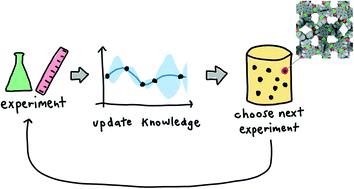当前位置:
X-MOL 学术
›
Mol. Syst. Des. Eng.
›
论文详情
Our official English website, www.x-mol.net, welcomes your
feedback! (Note: you will need to create a separate account there.)
Bayesian optimization of nanoporous materials
Molecular Systems Design & Engineering ( IF 3.2 ) Pub Date : 2021-10-06 , DOI: 10.1039/d1me00093d Aryan Deshwal 1 , Cory M. Simon 2 , Janardhan Rao Doppa 1
Molecular Systems Design & Engineering ( IF 3.2 ) Pub Date : 2021-10-06 , DOI: 10.1039/d1me00093d Aryan Deshwal 1 , Cory M. Simon 2 , Janardhan Rao Doppa 1
Affiliation

|
Nanoporous materials (NPMs) could be used to store, capture, and sense many different gases. Given an adsorption task, we often wish to search a library of NPMs for the one with the optimal adsorption property. The high cost of NPM synthesis and gas adsorption measurements, whether these experiments are in the lab or in a simulation, often precludes exhaustive search. We explain, demonstrate, and advocate Bayesian optimization (BO) to actively search for the optimal NPM in a library of NPMs—and find it using the fewest experiments. The two ingredients of BO are a surrogate model and an acquisition function. The surrogate model is a probabilistic model reflecting our beliefs about the NPM-structure–property relationship based on observations from past experiments. The acquisition function uses the surrogate model to score each NPM according to the utility of picking it for the next experiment. It balances two competing goals: (a) exploitation of our current approximation of the structure–property relationship to pick the NPM we believe [under uncertainty] will be the highest-performing, and (b) exploration of regions of NPM space we have not visited, to pick an NPM we are uncertain about and improve our approximation of the structure–property relationship. We demonstrate BO by searching an open database of ∼70 000 hypothetical covalent organic frameworks (COFs) for the COF with the highest simulated methane deliverable capacity (pertinent for vehicular adsorbed natural gas storage). BO finds the optimal COF and acquires ∼30% of the top 100 highest-ranked COFs after evaluating only ∼140 COFs. More, BO searches more efficiently than evolutionary and one-shot supervised machine learning approaches.
中文翻译:

纳米多孔材料的贝叶斯优化
纳米多孔材料 (NPM) 可用于存储、捕获和感应多种不同的气体。给定吸附任务,我们经常希望在 NPM 库中搜索具有最佳吸附特性的 NPM。NPM 合成和气体吸附测量的高成本,无论这些实验是在实验室中还是在模拟中,通常都无法进行详尽的搜索。我们解释、演示和提倡贝叶斯优化 (BO) 以在 NPM 库中主动搜索最佳 NPM,并使用最少的实验找到它。BO 的两个组成部分是代理模型和获取函数。代理模型是一个概率模型,反映了我们基于过去实验观察结果对 NPM-结构-性质关系的看法。获取功能使用代理模型根据为下一个实验选择它的效用对每个 NPM 进行评分。它平衡了两个相互竞争的目标:(a)利用我们目前对结构 - 性质关系的近似来选择我们认为 [在不确定性下] 将是性能最高的 NPM,以及(b)探索我们没有的 NPM 空间区域访问,选择一个我们不确定的 NPM 并改进我们对结构 - 属性关系的近似。我们通过搜索具有最高模拟甲烷输送能力(与车辆吸附天然气储存相关)的 COF 的~70 000 个假设共价有机框架(COF)的开放数据库来证明 BO。BO 找到最佳 COF 并在仅评估 140 个 COF 后获得前 100 个排名最高的 COF 中的 30%。更多的,
更新日期:2021-10-22
中文翻译:

纳米多孔材料的贝叶斯优化
纳米多孔材料 (NPM) 可用于存储、捕获和感应多种不同的气体。给定吸附任务,我们经常希望在 NPM 库中搜索具有最佳吸附特性的 NPM。NPM 合成和气体吸附测量的高成本,无论这些实验是在实验室中还是在模拟中,通常都无法进行详尽的搜索。我们解释、演示和提倡贝叶斯优化 (BO) 以在 NPM 库中主动搜索最佳 NPM,并使用最少的实验找到它。BO 的两个组成部分是代理模型和获取函数。代理模型是一个概率模型,反映了我们基于过去实验观察结果对 NPM-结构-性质关系的看法。获取功能使用代理模型根据为下一个实验选择它的效用对每个 NPM 进行评分。它平衡了两个相互竞争的目标:(a)利用我们目前对结构 - 性质关系的近似来选择我们认为 [在不确定性下] 将是性能最高的 NPM,以及(b)探索我们没有的 NPM 空间区域访问,选择一个我们不确定的 NPM 并改进我们对结构 - 属性关系的近似。我们通过搜索具有最高模拟甲烷输送能力(与车辆吸附天然气储存相关)的 COF 的~70 000 个假设共价有机框架(COF)的开放数据库来证明 BO。BO 找到最佳 COF 并在仅评估 140 个 COF 后获得前 100 个排名最高的 COF 中的 30%。更多的,











































 京公网安备 11010802027423号
京公网安备 11010802027423号